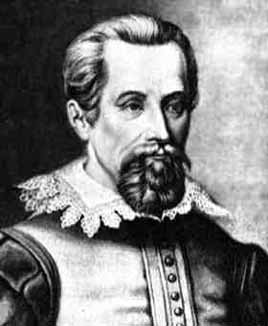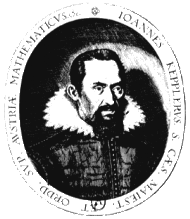Allgemein
Johannes Kepler Biographie
Johannes Kepler, auch das
Siebenmonatskind genannt, wurde am 27. Dezember
1571 in einer kleinen, fensterlosen Kammer in
einem bescheidenen Fachwerkhaus in der kleinen
Reichsstadt Weil als Sohn von Katharina
(1547-1622) und Heinrich Kepler (1547-1590)  geboren.
Johannes Kepler interessierte sich schon in
seinem 6. Lebensjahr für Kometen. Sein
Erstlingswerk von 1596, "Mysterium
cosmographicum" enthält
das Grundprinzip des Kopernikanischen Weltbildes,
wonach die Sonne den Mittelpunkt bildet und die
Planeten, einschließlich der Erde in Kreisbahnen
mit zusätzlichen Hilfskreisen die Sonne
umrunden. Von 1593 bis 1600 war er Lehrer
für Mathematik und Moral an der Stiftsschulein
Graz. Wegen der Ausweisung der Protestanten
mußte er Graz verlassen. 1600 war er Gehilfe von
Tycho Brahe in Prag, nach dessen Tod (1601) wurde
er sein Nachfolger als kaiserlicher Mathematiker.
1609 fand er aufgrund der Beobachtungsergebnisse
Tycho Brahes in Prag die ersten beiden, nach ihm
benannten Gesetze (die "Keplerschen
Gesetze"). geboren.
Johannes Kepler interessierte sich schon in
seinem 6. Lebensjahr für Kometen. Sein
Erstlingswerk von 1596, "Mysterium
cosmographicum" enthält
das Grundprinzip des Kopernikanischen Weltbildes,
wonach die Sonne den Mittelpunkt bildet und die
Planeten, einschließlich der Erde in Kreisbahnen
mit zusätzlichen Hilfskreisen die Sonne
umrunden. Von 1593 bis 1600 war er Lehrer
für Mathematik und Moral an der Stiftsschulein
Graz. Wegen der Ausweisung der Protestanten
mußte er Graz verlassen. 1600 war er Gehilfe von
Tycho Brahe in Prag, nach dessen Tod (1601) wurde
er sein Nachfolger als kaiserlicher Mathematiker.
1609 fand er aufgrund der Beobachtungsergebnisse
Tycho Brahes in Prag die ersten beiden, nach ihm
benannten Gesetze (die "Keplerschen
Gesetze").
Er erfand im Jahre 1611 ein
Fernrohr, das das von Galilei durch größere
Lichtstärke und ein größeres Gesichtsfeld
übertrifft. Die Rudolphinischen Tafeln von 1627,
genannt nach seinem verstorbenen
"Dienstherrn" Rudolph II, die bis zum
18. Jahrhundert die Grundlagen
allerastronomischen Berechnungen waren, waren
sein letztes großes Werk. Sie enthalten Angaben
für Sonnen- und Mondstellungen, aus denen auch
die Sonnen und Mondfinsternisse abzulesen waren.
1630 unternimmt er seine letzten Reisen von Sagan
nach Regensburg über insgesamt 600 Kilometer. In
Regensburg angekommen lebte Johannes Kepler keine
halbe Woche mehr. Er starb am 15. November 1630
an Fieber und Feuerpusteln.
http://www.kepler.fr.bw.schule.de/johannes/biographie.htm
Johannes Kepler
mit warheit mag
ichs sagen
das so oft ich die schöne ordnung
wie eins aus dem anderen folget vnd abgenommen
wirdt
mit meinen gedancken auff einmahl durchlauffe
so ists
alls hett ich ein göttlichen
nit mit bedeuttenden buchstaben
sondern mit wesentlichen dingen in die Welt
selbsten geschribenen Spruch gelesen
dessen inhalts: Mensch streckh deine Vernunfft
hieher
diese dinge zu begreiffen.
(Kepler
in seinem Kalender auf das Jahr 1604.)
http://www.idv.uni-linz.ac.at/kepler/index.html
 Encyclopædia Britannica: Johannes
Kepler Encyclopædia Britannica: Johannes
Kepler
German astronomer who discovered
three major laws of planetary motion,
conventionally designated as follows: (1) the planets move in
elliptical orbits with the Sun at one focus; (2)
the time necessary to traverse any arc of a
planetary orbit is
proportional to the area of the sector between
the central body and that arc (the "area
law"); and (3) there is an exact
relationship between the squares of the planets'
periodic times and the cubes of the radii of
their orbits (the "harmonic law").
http://britannica.com/bcom/eb/article/idxref/0/0,5716,400784,00.html
Johannes Kepler
Johannes Kepler (1571--1630). Born
on 27 December 1571 in Weil der Stadt, near
Stuttgart, in a modest family. He graduated at
age 20 from the University of Tuebingen, where he
studied mathematics and astronomy under Michael
Maestlin (1550--1631), an early supporter of the
Copernican system.
http://www.hao.ucar.edu/public/education/sp/images/kepler.html
Johannes Kepler: The Laws of Planetary
Motion
In the
interplay between quantitative observation and
theoretical construction that characterizes the
development of modern science, we have seen that Brahe was the
master of the first but was deficient in the
second. The next great development in the history
of astronomy was the theoretical intuition of
Johannes Kepler (1571-1630), a German who went to
Prague to become Brahe's assistant.
http://csep10.phys.utk.edu/astr161/lect/history/kepler.html
Johannes Kepler
On December 27, 1571, in the town of
Weil in Germany, Johannes Kepler came into this
world. In 1591 he graduated from a state school.
At the age of twenty three he began a teaching
career at Graz in Styria. Kepler truly believed
in the harmony of the universe. This harmony
influenced all of his writing and research.
Kepler looked for harmonies that existed, and
could be proven to exist.
http://www.cwrl.utexas.edu/~scoggins/316british/seventeenth/kepler.html
Johannes Kepler
The German astronomer Johannes
Kepler, b. Dec. 27, 1571, d. Nov. 15, 1630, was
the first strong supporter of the heliocentric
theory of Copernicus and the discoverer of the
three laws of planetary motion. At the age of 24,
Kepler published Mysterium cosmographicum
(Cosmographic Mystery, 1596), in which he
defended the Copernican theory and described his
ideas on the structure of the planetary system.
Influenced by the Pythagoreans, Kepler viewed the
universe as being governed by geometric
relationships that conform to the inscribed and
circumscribed circles of the five regular
polygons.
http://sirius.phy.hr/~dpaar/fizicari/xkepler.html
Johannes
Kepler, ein großer Mensch und Wissenschaftler
Rosemarie Schauerhammer
Wir können heute von Johannes Kepler, dem Begründer der
Wissenschaft der Astrophysik, viel mehr lernen, als wichtige
Wissenschaftsergebnisse. Keplers besonderer Schatz für uns
"moderne Menschen" ist seine Methode der
Hypothesenbildung, die er uns völlig offen darlegt. Denn er
sagte in seiner Astronomia Nova: "Mir kommen die
Wege, auf denen die Menschen zur Erkenntnis der himmlischen
Dinge gelangen, fast ebenso bewunderungswürdig vor wie die
Natur dieser Dinge selber. Daher zeige ich diese Wege mit
Sorgfalt auf." Sein ganzes Leben spürte Kepler dem
Weltenaufbau und den dem menschlichen Denken zugrundeliegenden
harmonischen Gesetze nach: "Was ist die Welt, aus welchem
Grund, nach welchem Plan ist sie von Gott geschaffen?"
Und im
Gegensatz zu modernen Wissenschaftspessimisten wußte Kepler,
daß der Mensch die Welt erkennen kann: "Für Gott liegen
in der ganzen Körperwelt körperliche Gesetze, Zahlen und
Verhältnisse vor, und zwar höchst erlesene und auf das beste
geordnete Gesetze... Jene Gesetze liegen innerhalb des
Fassungsvermögens des menschlichen Geistes; Gott wollte sie
uns erkennen lassen, als er uns nach seinem Ebenbild erschuf,
damit wir Anteil bekämen an seinem eigenen Gedanken. Denn was
steckt im Geiste des Menschen außer Zahlen und Größen?"
(Brief an Herwart, 1599).
http://www.solidaritaet.com/fusion/1996/2/kepler.htm
JOHANNES
KEPLER
And the Music of the Spheres
David Plant
Pythagoras discovered that the pitch of a musical note depends
upon the length of the string which produces it. This allowed
him to correlate the intervals of the musical scale with
simple numerical ratios. By associating measurements of length
with musical tones he made the first known reduction of a
quality (sound) into a quantity (length and ratio). The
understanding of nature through mathematics remains a primary
objective of science today. But Pythagoras also recognised
that the musical octave is the simplest and most profound
expression of the relationship between spirit and matter. The
short-lived but profoundly influential Pythagorean Brotherhood
sought to unite "religion and science, mathematics
and music, medicine and cosmology, body, mind and spirit in an
inspired and luminous synthesis". The Pythagoreans
used music to heal the body and to elevate the soul, yet they
believed that earthly music was no more than a faint echo of
the universal 'harmony of the spheres'.
Plato, Pliny,
Cicero and Ptolemy are amongst the philosophers of the ancient
world who contemplated the music of the spheres. The doctrine
was transmitted to medieval Europe where it found its most
glorious expression in the architecture of great abbeys and
cathedrals consciously designed to conform to the proportions
of musical and geometric harmony. The English hermeticist
Robert Fludd (1574-1637) visualised grand celestial scales
spanning three octaves and linking levels of existence from
the sub-planetary elemental worlds to exultant choirs of
angelic intelligences beyond the stars. The beautiful
engravings which illustrate Fludd's encyclopaedic works are
amongst the most comprehensive descriptions of pre-Copernican
cosmology ever devised.
The ideals of
Pythagorean harmony inspired Copernicus himself. He realised
that a Sun-centred planetary system not only gave better
predictions of celestial motion but could also he expressed
through more elegant geometry — to the greater glory of God
the Creator.
Kepler's early
enthusiasm for the Copernican system was inspired by the same
sense of idealism. He could readily accept the Sun as the
centre of the planetary system, but the necessity of rejecting
circular orbits came as something of a shock. The circle is an
archetypal symbol of harmony and perfection; Kepler recoiled
with disgust when an unsightly bulge began to emerge from his
analysis of the orbit of Mars. Yet the elliptical orbits
eventually revealed a scheme of celestial harmony more subtle
and profound than any that had gone before.
http://www.astrology-world.com/kepler.html
|




